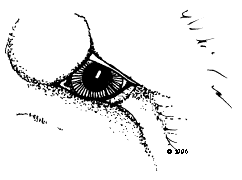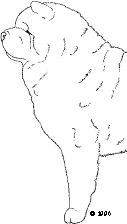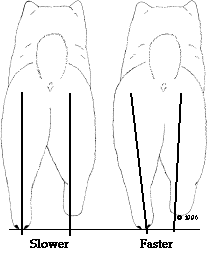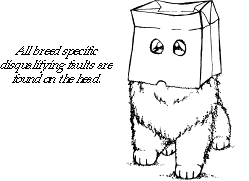Повна версія мовою оригіналу Ілюстрованого стандарту породи чау-чау Американського Кінологічного клубу.
-------------------------------------------------------------------------------------------------------------------------
The Illustrated Standard Of The Chow Chow

-
Published by the Chow Chow Club Inc.
Illustrated by Sandra L. Miller
Edited by Steven M. Miller
Adopted 1996
Revised 2002
----------------------------------------------------------------------------------------------------------------------
Anatomical Points Described in the Chow Chow Breed Standard
|
|
| Croup |
|
| Coupling | |
|
Stifle |
CHARACTERISTICS
An ancient breed of northern Chinese origin, this all-purpose dog of China was used for hunting, herding, pulling and protection of the home.
While primarily a companion today, his working origin must always be remembered when assessing true Chow type
GENERAL APPEARANCE
A powerful, sturdy, squarely built, upstanding dog of Arctic type, medium in size with strong muscular development and heavy bone. The body is compact, short coupled, broad and deep, the tail set high and carried closely to the back, the whole supported by four straight, strong, sound legs.

Viewed from the side, the hind legs have little apparent angulation and the hock joint and metatarsals are directly beneath the hip joint. It is this structure which produces the characteristic short, stilted gait unique to the breed.
The large head with broad, flat skull and short, broad and deep muzzle is proudly carried and accentuated by a ruff.
Elegance and substance must be combined into a well balanced whole, never so massive as to outweigh his ability to be active, alert and agile.
Clothed in a smooth or an off standing rough double coat, the Chow is a masterpiece of beauty, dignity and naturalness, unique in his blue-black tongue, scowling expression and stilted gait.
SIZE AND PROPORTIONS
Size
The average height of adult specimens is 17 to 20 inches at the withers but in every case consideration of overall proportions and type should take precedence over size :
Proportions
Square in profile and close coupled. Distance from forechest to point of buttocks equals height at thehighest points of the withers.
Serious Fault:
Profile other than square.

Distance from tip of elbow to ground is half the height at the withers. Floor of the chest level with tips of elbows.

Width viewed from the front and rear is the same and must be broad. It is these proportions that are essential to true Chow type. In judging puppies, no allowance should be made for their failure to conform to these proportions.
Substance
Medium in size with strong muscular development and heavy bone. Equally objectionable are snipy, fine boned specimens and overdone, ponderous, cloddy specimens.
In comparing specimens of different sex, due allowance must be made in favor of the bitches who may not have as much head or substance as do the males. There is an impression of femininity in bitches as compared to an impression of masculinity in dogs.

In evaluating the Chow Chow there are two unique features of breed type that seperate him from all other breeds:
The Stilted Gait and the solid blue/black tongue.
HEAD
Skull and Stop - proudly carried, large in proportion to the size of the dog but never so exaggerated as to make the dog seem top heavy or to result in a low carriage. The top skull is broad and flat from side to side and front to back. Coat and loose skin cannot substitute for the correct bone structure. Viewed in profile, the toplines of the muzzle and skull are approximately parallel, joined by a moderate stop. The padding of the brows may make the stop appear steeper than it is.
Muzzle - the muzzle is short in comparison to the length of the top skull but never less than one-third of the head length. The muzzle is broad and well filled out under the eyes, its width and depth are equal and both dimensions should appear to be the same from its base to its tip. This square appearance is achieved by correct bone structure plus padding of the muzzle and full cushioned lips. The muzzle should never be so padded or cushioned as to make it appear other than square in shape. The upper lips completely cover the lower lips when the mouth is closed but should not be pendulous.
Nose -large, broad and black in color with well opened nostrils.
Disqualifying Fault - nose spotted or distinctly other color than black, except in blue Chows which may have a solid blue or slate noses.
Mouth and Tongue - edges of the lips black, tissues of the mouth mostly black, gums preferably black. A solid black mouth is ideal. The top surface and edges of the tongue a solid blueblack, the darker the better.
Disqualifying Fault - the top surface or edges of the tongue red or pink or with one or more spots of red or pink.
Teeth -strong and even with a scissors bite.

Eyes
Dark brown, deep set and placed wide apart and obliquely, of moderate size, almond in shape. The correct placement and shape should create an Oriental appearance. The eye rims black with lids which neither turn in nor droop and the pupils of the eyes clearly visible.
Serious Faults - Entropion or ectropion, or pupils wholly or partially obscured by loose skin.

Ears
Small, moderately thick, triangular in shape with a slight rounding at the tip, carried stiffly erect but with a slight forward tilt. Placed wide apart with the inner corner on top of the skull. An ear which flops as the dog moves is very undesirable.
Disqualifying Fault - Drop ear or ears. A drop ear is one which breaks at any point from its base to its tip or which is not carried stiffly erect but lies parallel to the top of the skull.

Expression
Essentially scowling, dignified, lordly, discerning, sober and snobbish, one of independence.
The scowl is achieved:
* by a marked brow with a padded button of skin just above the inner, upper corner of each eye;
* by sufficient play of skin to form frowning brows and a distinct furrow between the eyes beginning at the base of the muzzle and extending up the forehead;
* by the correct eye shape and placement, and
* by the correct ear shape, carriage and
placement.
Excessive loose skin is not desirable. Wrinkles on the muzzle do not contribute to expression and are not required.

NECK AND BODY
Neck
Strong, full, well muscled, nicely arched and of sufficient length to carry the head proudly above the topline when standing at attention.
Body
Short, compact, close coupled, strongly muscled, broad, deep and well let down in the flank.
Topline
Straight, strong and level from the withers to the root of the tail.

The correct chest and topline. Note again the equal, balanced proportions.
Chest
Broad, deep and muscular, never narrow or slab-sided. The ribs close together and well sprung, not barrel. The spring of the front ribs is somewhat narrowed at their lower ends to permit the shoulder and upper arm to fit smoothly against the chest wall. The floor of the chest is broad and deep extending down to the tips of the elbows. The point of sternum slightly in front of the shoulder points.
Serious Faults
Labored or abdominal breathing (not to include normal panting), narrow or slab-sided chest.
Loin
Well muscled, strong, short, broad and deep.
Croup
Short and broad with powerful rump and thigh muscles giving a level croup. The body, back, coupling and croup must all be short to give the required square build.
Tail
Well feathered, set high and carried closely to the back at all times, following the line of the spine at the start.
FOREQUARTERS
Shoulders
Shoulders are strong, well muscled the tips of the shoulder blades moderately close together; the spine of the shoulder forms an angle of approximately 55 degrees with the horizontal and forms an angle with the upper arm of approximately 110 degrees resulting in less reach of the forelegs. Length of upper arm never less than length of shoulder blade. Elbow joints set well back alongside the chest wall, elbows turning neither in nor out.

Forelegs
Forelegs are perfectly straight from elbow to foot with heavy bone which must be in proportion to the rest of the dog. Viewed from the front, the forelegs are parallel and widely spaced commensurate with the broad chest.

Pasterns
Pasterns are short and upright. Wrists shall not knuckle over.

Feet
Feet are round, compact, cat-like, standing well up on the thick toe pads. The dewclaws may be removed.
HINDQUARTERS
Rear Assembly
The rear assembly is broad, powerful, and well muscled in the hips and thighs, heavy in bone with rear and front bone approximately equal. Viewed from the rear, the legs are straight, parallel and widely spaced commensurate with the broad pelvis.
Stifle Joint
The stifle joint shows little angulation, is well knit and stable, points straight forward and the bones of the joint should be clean and sharp.

Hock Joint
The hock joint is well let down and appears almost straight. The hock joint must be strong, well knit and firm, never bowing or breaking forward or to either side. The hock joint and metatarsals lie in a straight line below the hip joint.
Serious Faults
Unsound stifle or hock joints.
Metatarsals
Short and perpendicular to the ground.
COAT
There are two types of coat; rough and smooth. Both are double coated.
Rough
In the rough coat, the outer coat is abundant, dense, straight and off standing, rather coarse in texture; the undercoat soft, thick and woolly.
Puppy coat soft, thick and woolly overall.
The coat forms a profuse ruff around the head and neck, framing the head. The coat and ruff generally longer in dogs than in bitches. The coat length varies markedly on different Chows and thickness, texture and condition should be given greater emphasis than length.
Obvious trimming or shaping is undesirable. Trimming of the whiskers, feet and metatarsals optional.
Smooth
The smooth coated Chow is judged by the same
standard as the rough coated Chow except that references to the quantity and distribution of the outer coat are not applicable to the smooth coated Chow, which has a hard, dense, smooth outer coat with a definite undercoat. There should be no obvious ruff or feathering on the legs or tail.COLOR
Clear colored, solid or solid with lighter shadings in the ruff, tail and featherings.
There are five colors in the Chow:
*Red (light golden to deep mahogany),
*Black,
*Blue,
*Cinnamon
(light fawn to deep cinnamon), and*Cream.
Acceptable colors to be judged on an equal basis.

The illustrations in this standard demonstrate that coat is the only specified difference between the rough and smooth coated varieties. The above illustration is an overlay of the figures first shown on pages 3 and 4.
GAIT
Proper movement is the crucial test of proper conformation and soundness. It must be sound, straight moving, agile, brief, quick and powerful, never lumbering.
Rear Gait
The rear gait short and stilted because of the straighter rear assembly. It is from the side that the unique stilted action is most easily assessed.

The rear leg moves up and forward from the hip in a straight, stilted pendulum-like line with a slight bounce in the rump, the legs extend neither far forward nor far backward.
The hind foot has a strong thrust which transfers power to the body in an almost straight line due to the minimal rear leg angulation.
To transmit this power efficiently to the front assembly. the coupling must be short and there should be no roll through the midsection.
Viewed from the rear, the line of bone from hip joint to pad remains straight as the dog moves. As the speed increases the hindlegs incline slightly inward.


The stifle joints must point in the line of travel, not outward resulting in a bowlegged appearance nor hitching in under the dog.
GAIT
Proper movement is the crucial test of proper conformation and soundness. It must be sound, straight moving, agile, brief, quick and powerful, never lumbering.
Front Gait
Viewed from the front, the line of bone from shoulder joint to pad remains straight as the dog moves. As the speed increases, the forelegs do not move in exact parallel planes, rather, incline slightly inward. The front legs must not swing out in semicircles nor mince or show any evidence of hackney action.


The front and rear assemblies must be in dynamic equilibrium. Somewhat lacking in speed, the Chow has excellent endurance because the sound, straight rear leg provides direct, usable power efficiently.
TEMPERAMENT
Keen intelligence, an independent spirit and innate dignity give the Chow an aura of aloofness. It is a Chow's nature to be reserved and discerning with strangers.
Displays of aggression or timidity are unacceptable. Because of its deep set eyes the Chow has limited peripheral vision and is best approached within the scope of that vision.

Always approach the Chow directly from the front, never from the side or rear, with the first contact being under the chin, not over the top of the head. 
PRESENTATION
The Chow Chow is a natural breed, best presented in natural coat, without excess trimming or shaping.
The Chow Chow's gait is best evaluated when presented on a loose lead, allowing the dog to freely exhibit his natural stilted gait.
SUMMARY
Faults shall be penalized in proportion to their deviation from the standard. In judging the Chow, the overall picture is of primary consideration.
Exaggeration of any characteristic at the expense of balance or soundness shall be severely penalized.
Equally objectionable are snipey, fine boned specimens and overdone, ponderous, cloddy specimens.
In comparing specimens of different sex, due allowance must be made in favor of the bitches who may not have as much head or substance as do the males. There is an impression of femininity in bitches as compared to an impression of masculinity in dogs.
Type should include general appearance, temperament, the harmony of all parts, and soundness especially as seen when the dog is in motion.
There should be proper emphasis on movement which is the final test of the Chow's conformation, balance and soundness.
Disqualifications
*Nose spotted or distinctly other color than black except in blue Chows which may have solid blue or slate noses.

*The top surface or edges of the tongue red or pink or with one or more spots of red or pink.
*Drop ear or ears. A drop ear is one which breaks at any point from its base to its tip or which is not carried stiffly erect but lies parallel to the top of the skull.
Serious Faults
*Profile other than square.
*Entropion or ectropion, or pupils wholly or partially obscured by loose skin.
*Labored or abdominal breathing (not to include normal panting), narrow or slab-sided chest.
*Unsound Stifle or Hock Joint
Glossary Of Terms
Almond eyes: An elongated eye-shape describing the tissue surrounding the eye itself.
Agulation: The angles formed by the appendicular skeleton, including the forequarters, arm, forearm, wrist, pastern, toes and hindquarters, thigh, second thigh, hock, rear pastern, toes.
Back: The dorsal surface (topline) of the dog extending, from the withers to the croup, including the thoracic and lumbar vertebral regions; infrequently used to refer only to the thoracic region.
Balanced: A condition wherein all proportions of a dog are in static and dynamic harmony.
Barrel: A rib (thoracic) region that is circular in cross-section.
Bitch: A female canine.
Bite: The relative position of the upper and lower teeth when the jaw is closed, including scissors, level, undershot and overshot.
Bone: A type of connective tissue that forms the canine skeleton. Informally used to suggest a quantitative characteristic of limb bones in proportion to overall size of a dog.
Buttocks: The rump or hips.
Cat-foot: Round, compact foot, with well arched toes, tightly bunched or close-cupped.
Chest: The part of the body or trunk that is enclosed by the ribs; the thoracic cavity.
Cloddy: Low, thickset. comparatively heavy.
Close-coupled: Comparatively short from last rib to the commencement of the hindquarters.
Coarse: Lacking refinement.
Coat: The dog's hair covering.
Condition: Health as shown by the coat, state of flesh, general appearance and deportment.
Conformation: The form and structure. make and shape; arrangement of the parts in conformance with breed-standard demands.
© 1996-2007 The Chow Chow Club Inc. - All rights reserved.







